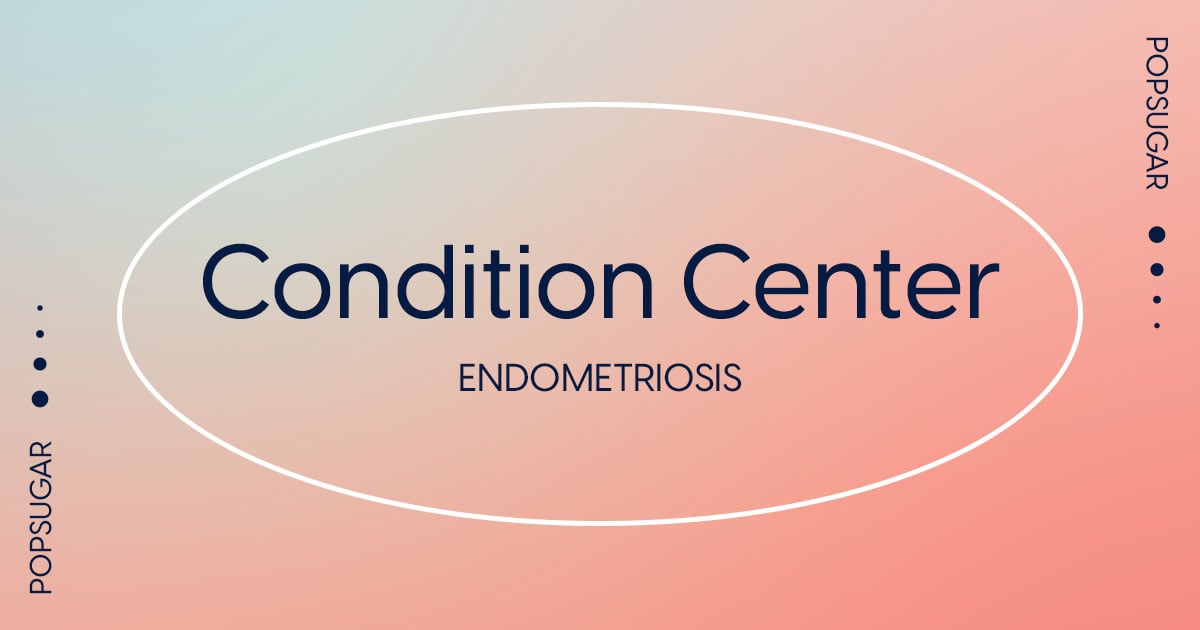This informational guide, part of POPSUGAR’s Condition Center, lays out the realities of this health concern: what it is, what it can look like, and strategies that medical experts say are proven to help. You should always consult your doctor regarding matters pertaining to your health and before starting any course of medical treatment.
Pelvic pain — especially around one’s period — is incredibly common. But while a little cramping is normal, severe pain with your period can be a red flag for endometriosis, a condition that occurs when the tissue lining the uterus, the endometrium, begins growing on the ovaries, fallopian tubes, and other places outside of the uterus, says Hugh Taylor, MD, professor and chair of obstetrics at Yale University School of Medicine. “Because it’s often mistaken for normal period-related pain, endometriosis is frequently misdiagnosed and left untreated for years, which causes unnecessary suffering and can lead to a number of additional health problems,” he says. Your best protection: recognizing the signs and bringing them to your doctor’s attention early.
What Is Endometriosis?
The condition occurs when tissue lining the uterus grows outside of the uterus. The most common symptom of endometrios is pain: painful menstrual cramps, chronic low-back and pelvis pain, pain deep in the vagina during and after sex, intestinal pain, and pain with bowel movements or urination.
“Pain is tricky, because it’s subjective and, as a result, it’s easy for doctors — and even the patients themselves — to dismiss it,” says Dr. Taylor. “But if you miss work or can’t exercise or do things you normally do, it’s not ‘normal’ period pain.” If you find yourself lying in bed all day with a heating pad or needing to take large amounts of pain medicine during your period, you should definitely alert your medical provider.
Endometriosis affects up to 10 percent of people with uteruses who are of reproductive age, especially those in their 30s and 40s.
What Are Symptoms of Endometriosis?
Endometriosis is typically marked by symptoms of pain, including:
- Painful menstrual cramps
- Chronic lower back and pelvis pain
- Pain deep in the vagina during and after sex
- Intestinal pain
- Pain with bowel movements or urination
The condition can have other symptoms, too, like fatigue, diarrhea, depression, and anxiety. “Endometriosis causes inflammation, which affects the whole body,” says Dr. Taylor. “It increases the risk of autoimmune disease and cardiovascular disease, and it changes genes and neurotransmitters in the brain. Getting a diagnosis and treatment is important.”
Endometriosis can make it more difficult to get pregnant because it can block fallopian tubes and cause ovarian cysts; as many as 30 to 40 percent of people with endometriosis are infertile (meaning they won’t get pregnant after having unprotected sex for a year).
What Causes Endometriosis?
While the cause of the disorder is not known, experts have theories about the risk factors and possible causes of endometriosis. They include:
- Excess estrogen, which thickens the lining of your uterus during your period.
- Retrograde menstrual flow, in which some of the tissue shed during your period goes through the fallopian tube into the pelvis.
- Genes undoubtedly play a role in some people as well. “If your mother or sister has endometriosis, you’re at very high risk,” says Dr. Taylor.
- Cell transformation. In a process known as “induction theory,” hormones or immune factors may cause certain cells that line the inner side of your abdomen to turn into endometrial-like cells.
- After surgeries like a hysterectomy or C-section, endometrial cells may attach to the incision.
- Immune-system dysfunction that prevents the body from destroying endometrial-like tissue near the uterus.
There are a handful of other symptoms that may imply an increased risk of endometriosis, including getting your period before age 11, having short menstrual cycles (27 days or fewer), and having heavy periods that last longer than seven days.
Pregnancy and breastfeeding lower the risk, according to a 2017 study out of Harvard. Why? The researchers suggested that breastfeeding may extend postpartum amenorrhea (aka, how long it takes your period to return after being pregnant), which may reduce the likelihood of retrograde menstrual flow. Breastfeeding is also thought to alter the circulation of certain hormones that impact endometriosis, including oxytocin, estrogen, and gonadotrophin-releasing hormone, while ovulation suppression that occurs during pregnancy and lactation decreases stimulation to the endometriosis.
How Is Endometriosis Diagnosed?
Despite the high stakes, an endometriosis diagnosis can take anywhere between four and 11 years on average, according to the American Journal of Obstetrics and Gynecology. And race and ethnicity can be a barrier to diagnosis. Research has shown, for example, that Black people are nearly half as likely to be diagnosed with endometriosis as their white peers due to social factors like implicit bias. Many are misdiagnosed instead, often times with Pelvic Inflammatory Disease (PID), a sexually transmitted disease.
A pelvic exam, ultrasound, or MRI may reveal physical clues of endometriosis, though a normal test does not rule out endometriosis. The only definitive way to diagnose it is through laparoscopic surgery. Dr. Taylor and others, however, believe the telltale symptoms are enough to make the diagnosis. “If you have painful periods that are getting worse over time, or period-like pain that occurs during other stages of the menstrual cycle, it’s almost always endometriosis,” he says. You can try some noninvasive strategies that often work to ease endometriosis symptoms, even without having an official diagnosis.
How Is Endometriosis Treated?
Unfortunately, there is no cure for endometriosis. If you’re not trying to get pregnant, hormonal birth control — usually the pill — is the medication doctors try first. “It reduces estrogen and increases progesterone, which helps with endometriosis,” says Dr. Taylor. “It’s simple, inexpensive, and benign.” But it doesn’t work for everyone.
An ovulation-suppressing medication known as gonadotropin-releasing hormone (GnRH) agonist also lowers estrogen — and can serve as an alternative for those who don’t get relief with the pill. If your pain gets better with either medication, you’ll have additional confirmation that the symptom was almost certainly being caused by endometriosis. These drugs don’t cure the condition, however. When you stop taking them, the endometriosis symptoms may come back. When you go through menopause, however, most symptoms will stop.
If medications don’t provide relief, or if you’re trying to get pregnant and are experiencing fertility problems, you may need to have surgery to remove the endometriosis. If you’re struggling to conceive, your doctor may also recommend fertility treatment, such as ovarian stimulation (to encourage the ovaries to make more eggs) or in vitro fertilization (IVF).
When to Contact a Doctor
Again, general pelvic pain — particularly around one’s period — is relatively common. But severe pain with your period is not normal and should not be ignored. Finding a doctor who will listen to you is essential. “If you’re having extreme pain during your period and your doctor doesn’t take it seriously, find a gynecologist who is knowledgeable about endometriosis,” Dr. Taylor says. “You need a doctor who listens to you when you say you’re having severe period pain — and who knows what it means.”
— Additional reporting by Alexis Jones
Alexis Jones is the senior health editor at POPSUGAR. Her areas of expertise include women’s health, mental health, racial and ethnic disparities in healthcare, diversity in wellness, and chronic conditions. Prior to joining POPSUGAR, she was the senior editor at Health magazine. Her other bylines can be found at Women’s Health, Prevention, Marie Claire, and more.
Ginny Graves is a POPSUGAR contributor.


